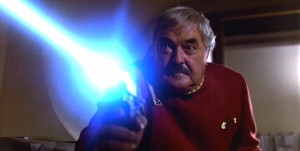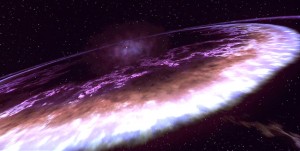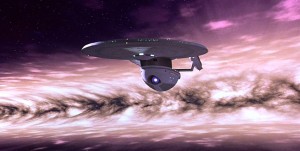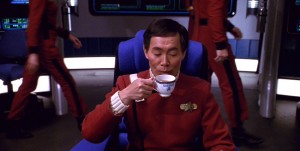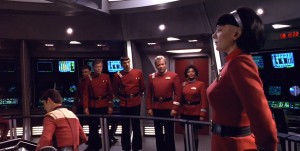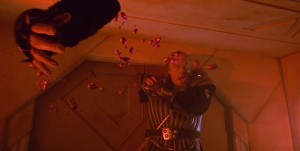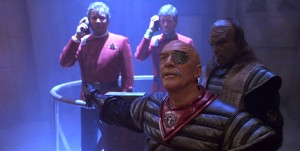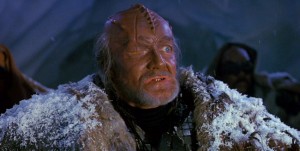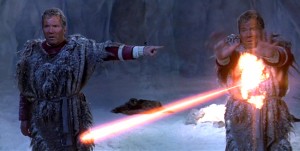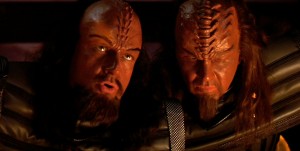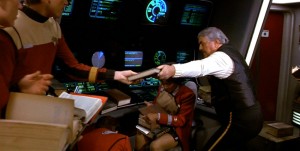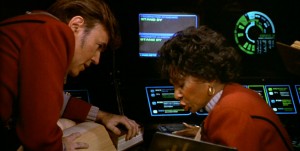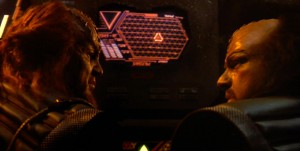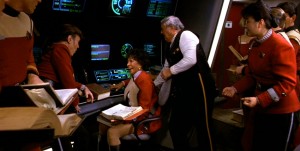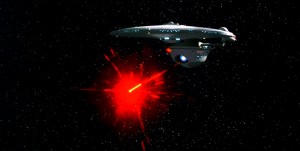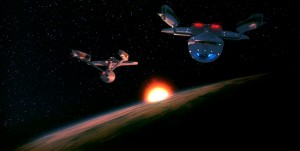The writers and creators of Star Trek had a lot of damage control to do. Star Trek V: The Final Frontier didn’t live up to their financial expectations (surprise, surprise) and they needed to bring the franchise back…or at least end it on a more positive note. Nicholas Meyer returned to direct this film, which was met with mixed feelings. Having directed the rather pitiful Star Trek: The Motion Picture and the extremely successful Star Trek II: The Wrath of Khan, fans weren’t sure what they were in for. It turned out however that the movie wasn’t half bad…in fact the film turned out to be pretty damn good. It was the only Star Trek film to be awarded the Saturn Award for Best Science Fiction Film. It had a good mix of both humor and suspense. Leonard Nimoy had a hand in writing the script so I must conclude that it was all him. All credit therefore should go to Leonard Nimoy. Concerning anything. There is no other possibility. Resistance is fut…not logical.
This film was much darker than its predescesors…I guess the universe ran out of probes that needed to talk to whales. In any event, the story is primarily a dramatic whodunit that tests the fragile peace the Federation and Klingons are attempting to forge after a tragic accident on the Klingon moon, Praxis. An explosion on said moon sends the Klingon economy into an upheaval, going as far as to threaten the end of their race. The Klingons have little choice but to tuck their tails between their legs and ask the Federation for help, even though there are some who would rather die than ask for help from the Federation. The Klingons are a warlike race and don’t see much honor in letting a long-standing enemy gain a foothold in their territory without having fired a single shot. To be fair, some in the Federation feel that it would be better to just let the Klingons die off.
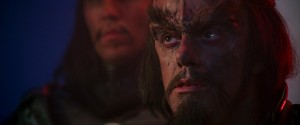
Flashback: In Star Trek III, Christopher Lloyd is responsible for killing Kirk’s son, David Marcus. This plot point plays a pivotal role in Star Trek VI.
That, in a nutshell, is how Star Trek VI: The Undiscovered Country begins. We’re treated to seeing “Captain” Sulu ride the shockwave of the explosion on his new ship, the USS Excelsior. After surviving the wave, they report the explosion of Praxis to Starfleet, where the plan to negotiate for peace, aid, and relief begins. As I mentioned before, some were against that plan of action, but more on that later.
The Enterprise is sent to the Neutral Zone to escort Klingon Ambassador Gorkon’s ship to Earth where the peace talks will begin. Along the way to the Neutral Zone we’re treated to Kirk’s feelings on the peace talks and Klingons in general. He goes on for about a minute, depressing his personal log into such a suicidal state that only Zoloft could save it. It’s also worth noting at this point the introduction of Lieutenant Valeris who is Spock’s…trainee, if you will…to eventually succeed him. Everyone in the movie theatre shed a collective tear after Spock announced that this would be his final voyage aboard the Starship Enterprise. The world was indeed coming to an end.
They meet up with the Klingon ship and invite the Klingon delegation to dinner. Introductions are made, dinner is served, Shakespeare is quoted, and we all find out just how different these two species are…making everyone wonder just how likely peace would be the end result of this all. In the words of General Chang, Gorkon’s Chief of Staff, “To be or not to be. That is the question that preoccupies our people, Captain Kirk.”
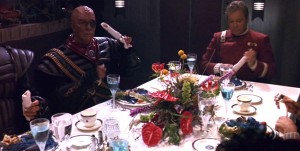
Narrator: “We’ve replaced General Chang’s disruptor with a Starfleet issue napkin. Let’s see if he notices…”
Shortly after the Klingons return to their ship, we’re treated to Spock dragging Kirk’s grumpy, slightly buzzed behind to the bridge to report an anomalous reading. On que, disaster strikes. Photon torpedoes hit the Klingon vessel and causes it to spin out of control. Two people in Starfleet uniforms beam aboard the Klingon ship and begin shooting, eventually taking out the Ambassador himself. They beam away while Kirk and company scramble to find out what is going on and whether or not they actually fired. This part of the movie was pretty gruesome, especially for a Trek movie. It can be compared to Super Sloppy Double Dare, only substitute green slime for purple blood.
Once the dust clears, Kirk and McCoy beam aboard the Klingon ship to provide aid. McCoy is unable to save the Ambassador, resulting in the away team’s immediate arrest. Spock, on board the Enterprise, is bound by orders not to begin a war by attempting to retrieve them and must watch as the Klingons begin their trek back to Klingon space. Kirk and McCoy ending up standing trial. It’s worth noting (at least, the Trekkies will think so) that Michael Dorn showed up as Colonel Worf, the grandfather of Lieutenant Worf, to defend Kirk and McCoy during the trial. For those of you who have no idea what I’m talking about, Lieutenant Worf played a major role in Star Trek: The Next Generation and Star Trek: Deep Space Nine.
Anyway, Kirk and McCoy are sentenced to life on the penal asteroid of Rura Penthe, a barren ball of ice on the surface where conditions beneath aren’t much better. We get the idea from the cast that those sent to this place don’t last very long. After arriving, Kirk and McCoy begin their plot to escape with the help of a shapeshifter, who ends up turning on them in order to get a full pardon. Kirk, however, wasn’t about to go down without a fight.
Spock, on board the Enterprise, has two goals. He not only has to figure out how to get his comrades back, but piece together what happened the night of the assassination. Did the Enterprise fire on the Klingon vessel? What about the two crewmen who beamed aboard and shot the Ambassador? Once again, Spock takes up the role of Sherlock Holmes and through logical deduction, starts getting answers while navigating the Enterprise through Klingon space to attempt a rescue.
To make a long story short, they rescue Kirk and McCoy and solve the mystery. Since this is a whodunit, I’ll break from my usual pattern and leave out the details. Suffice it to say, the peace talks resume and another assassination attempt is afoot. It’s up to Kirk and company to get to the conference to stop the conspirators (who are against the peace talks) from having their way. I’ll end the plot synopsis there. Even though the movie is old, I hate spoiling a whodunit, especially if by some chance you plan to watch it in the future.
My take on the movie? The movie was good. It was not better than Khan, but probably my second favorite out of the six movies that featured the original cast. Kirk is finally forced to come to terms with the death of his son while knee-deep in a conspiracy that framed him to get him out of the way. The whodunit mystery wasn’t exactly Sir Arthur Conan Doyle material and if you think about it hard enough, you can deduce who the conspirator(s) were. The movie does have an action sequence (space battle) at the end, though I don’t want to say between who as to not give away the story. I particularly enjoyed that fight sequence, even though it was short-lived.
As the last movie featuring the crew of the Enterprise and Enterprise A, I was satisfied by the ending, but saddened to see the ride come to an end. Then again, there is always Star Trek: The Next Generation and its movie saga. From here on out, I’ll be covering Star Trek: The Next Generation episodes and its corresponding movies.
I’d like to end this article by addressing the complaint people have in regards to Star Trek being “too boring” to watch. Gene Roddenberry didn’t make Star Trek to impress and draw people in with space battles…he did it to address popular issues that were plaguing the 60s at the time. What I find admirable about Star Trek is its ability to continue to relate to the issues that are rampant in today’s society. The first interracial kiss on national television was a big deal. Having an Asian helmsman, a Scottish engineer, an African-American comm officer, a Russian navigator…you get the idea…was also kind of a big deal. The belief that one day mankind will solve disease, war, poverty, and greed give hope to the dreamers that know how to keep an open mind towards our future. Star Trek isn’t about “shooting em up”…Star Trek is about morality. Those who find Star Trek “too boring” are missing the point completely.

